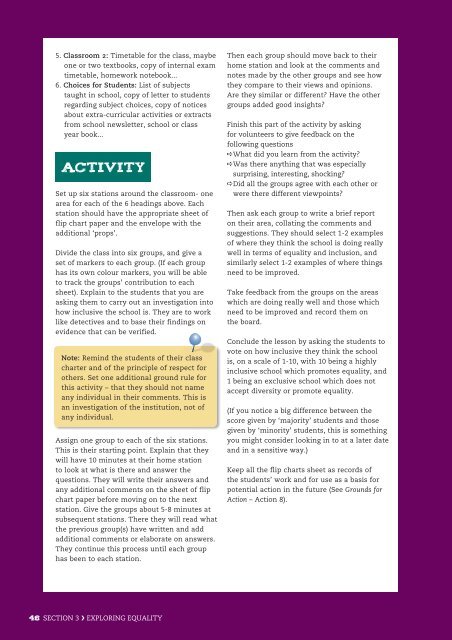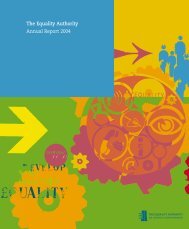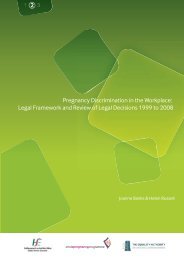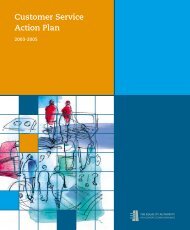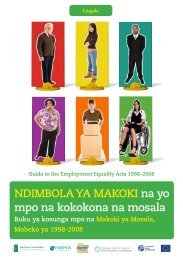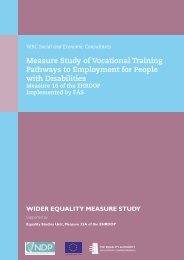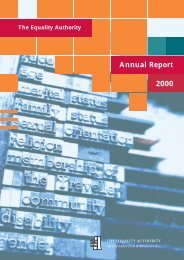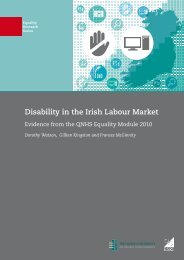Equality and Diversity - Building a Culture of ... - Equality Authority
Equality and Diversity - Building a Culture of ... - Equality Authority
Equality and Diversity - Building a Culture of ... - Equality Authority
You also want an ePaper? Increase the reach of your titles
YUMPU automatically turns print PDFs into web optimized ePapers that Google loves.
5. Classroom 2: Timetable for the class, maybe<br />
one or two textbooks, copy <strong>of</strong> internal exam<br />
timetable, homework notebook...<br />
6. Choices for Students: List <strong>of</strong> subjects<br />
taught in school, copy <strong>of</strong> letter to students<br />
regarding subject choices, copy <strong>of</strong> notices<br />
about extra-curricular activities or extracts<br />
from school newsletter, school or class<br />
year book...<br />
Activity<br />
Set up six stations around the classroom- one<br />
area for each <strong>of</strong> the 6 headings above. Each<br />
station should have the appropriate sheet <strong>of</strong><br />
flip chart paper <strong>and</strong> the envelope with the<br />
additional ‘props’.<br />
Divide the class into six groups, <strong>and</strong> give a<br />
set <strong>of</strong> markers to each group. (If each group<br />
has its own colour markers, you will be able<br />
to track the groups’ contribution to each<br />
sheet). Explain to the students that you are<br />
asking them to carry out an investigation into<br />
how inclusive the school is. They are to work<br />
like detectives <strong>and</strong> to base their findings on<br />
evidence that can be verified.<br />
Note: Remind the students <strong>of</strong> their class<br />
charter <strong>and</strong> <strong>of</strong> the principle <strong>of</strong> respect for<br />
others. Set one additional ground rule for<br />
this activity – that they should not name<br />
any individual in their comments. This is<br />
an investigation <strong>of</strong> the institution, not <strong>of</strong><br />
any individual.<br />
Assign one group to each <strong>of</strong> the six stations.<br />
This is their starting point. Explain that they<br />
will have 10 minutes at their home station<br />
to look at what is there <strong>and</strong> answer the<br />
questions. They will write their answers <strong>and</strong><br />
any additional comments on the sheet <strong>of</strong> flip<br />
chart paper before moving on to the next<br />
station. Give the groups about 5-8 minutes at<br />
subsequent stations. There they will read what<br />
the previous group(s) have written <strong>and</strong> add<br />
additional comments or elaborate on answers.<br />
They continue this process until each group<br />
has been to each station.<br />
Then each group should move back to their<br />
home station <strong>and</strong> look at the comments <strong>and</strong><br />
notes made by the other groups <strong>and</strong> see how<br />
they compare to their views <strong>and</strong> opinions.<br />
Are they similar or different? Have the other<br />
groups added good insights?<br />
Finish this part <strong>of</strong> the activity by asking<br />
for volunteers to give feedback on the<br />
following questions<br />
What did you learn from the activity?<br />
Was there anything that was especially<br />
surprising, interesting, shocking?<br />
Did all the groups agree with each other or<br />
were there different viewpoints?<br />
Then ask each group to write a brief report<br />
on their area, collating the comments <strong>and</strong><br />
suggestions. They should select 1-2 examples<br />
<strong>of</strong> where they think the school is doing really<br />
well in terms <strong>of</strong> equality <strong>and</strong> inclusion, <strong>and</strong><br />
similarly select 1-2 examples <strong>of</strong> where things<br />
need to be improved.<br />
Take feedback from the groups on the areas<br />
which are doing really well <strong>and</strong> those which<br />
need to be improved <strong>and</strong> record them on<br />
the board.<br />
Conclude the lesson by asking the students to<br />
vote on how inclusive they think the school<br />
is, on a scale <strong>of</strong> 1-10, with 10 being a highly<br />
inclusive school which promotes equality, <strong>and</strong><br />
1 being an exclusive school which does not<br />
accept diversity or promote equality.<br />
(If you notice a big difference between the<br />
score given by ‘majority’ students <strong>and</strong> those<br />
given by ‘minority’ students, this is something<br />
you might consider looking in to at a later date<br />
<strong>and</strong> in a sensitive way.)<br />
Keep all the flip charts sheet as records <strong>of</strong><br />
the students’ work <strong>and</strong> for use as a basis for<br />
potential action in the future (See Grounds for<br />
Action – Action 8).<br />
48 SECTION 3 EXPLORING EQUALITY


